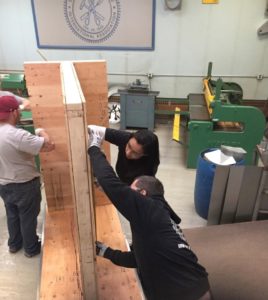
Story via the International Training Institute
With highly visible arenas, stadiums and high- rise commercial buildings under construction or renovation across the country, architectural sheet metal is gracefully stepping into the spotlight. For every high-profile project, there is an equally important local project that demands workers with specific skills and just-as-high expectations.
The International Training Institute for the sheet metal, air conditioning and welding industry (ITI) is working with JATCs, their local unions, manufacturers, and contractors to turn expectations and opportunities into education through various levels of classes created to suit skill-level demand.
In February, the first of the “strike force training” courses took place at Local No. 19 in Philadelphia. These types of courses introduce our local unions to manufacturers and create training opportunities for members to learn how to install complex systems used on projects out for bid. Dan McCallum, ITI architectural specialist, coordinates the training with local union business managers, manufacturers, and contractors to learn about the project to determine the course training material that’s needed.
During the class, two systems were demonstrated, including the Formawall Dimension Series, insulated metal wall panel systems, and MetalWrap, insulated composite backup wall panel.
Centria, one of the leading manufacturers of building envelope systems, provided the training and materials for the course.
“These are modular type systems. System components, their detailing and sequence of installation is specific and critical for a properly installed wall system installation,” McCallum said. “There are many nuances to each system’s installation. We’re increasing the knowledge base of our members on those modular type systems.”
Training members ahead of a project’s start results in higher retention rates, knowledge and skills. This type of training improves the efficiency and the effectiveness of the installation.
“If you estimate a job at X number of hours, and workers are not trained, production suffers, labor hours increase, job costs rise and that estimate is ‘blown,’” he added. “You’re going to be more successful hitting those hours because they are more educated. You do better with people on the job who are trained rather than untrained.”
The first of its kind, this style of training is going to be more popular as contractors bid projects that require specific skills and demand training from the locals.
“We are working to assist the membership by accelerating the learning process with concentrated training,” McCallum said. “The ‘strike force training’ provides that in a quick fashion.”
As more projects are requiring specific systems from manufacturers, contractors are requesting training for their workers. The ITI has already fielded interest from other parts of the country that are experiencing the need for concentrated courses.
The class was held in addition to the ITI’s two annual architectural courses, which included metal roofing systems April 2-8 and metal wall panels in October, both in Philadelphia.
With an increasing demand, the ITI wants to make sure workers are not only trained, but certified on building enclosure knowledge.
At the end of the annual courses, students will take a proficiency test to certify in building enclosure knowledge. The more SMART workers who can achieve certifications, the better it is for the SMART union as a whole, McCallum said.
About 30 percent of the students in the April class had architectural sheet metal experience. McCallum said that will likely be the case the first few years until more members can be educated and certified.
“This is a journey. We’ve taken the first steps with these programs. The contractors are being more aggressive about bidding the projects. I really do believe everyone is moving forward with this,” McCallum said. “I’m proud to be a union sheet metal member, and I’m proud to see our contractors be a part of this. When you see a game on TV, and they show you an exterior shot of the stadium, you can see all that great sheet metal work, and it was likely done by a union sheet metal worker.”
According to the Metal Architecture Magazine’s 31st annual Architects Survey, whether it’s metal wall panels, roofs or building systems, architects report an increased specification of materials in 2016 over 2015, and they are expecting an even stronger 2017 with the anticipation of construction activity and greater involvement in the metal construction industry.
The survey also cited the 2017 Dodge Construction Outlook from Dodge Data & Analytics in National Harbor, Maryland, which predicted construction in the United States will have a 5 percent start increase to $713 billion, which is up significantly from 1 percent in 2016.
“From what I’m hearing during the classes, there is a genuine excitement,” McCallum said. “There is an interest and great sense of awareness.”
As the most visual aspect of the sheet metal trade — more than HVAC, welding, drafting, testing, adjusting and balancing, and service — architectural sheet metal allows workers to point it out to their children and their grandchildren and say, “I did that.”
These classes are the start to that, McCallum said.
“This is our legacy,” he added. “As long as that building stands, I can say I was a part of it.”
Related News
- Transit Funding Boost Proposed by SMART-TD Backed Bill
- California SMART-TD Brother Killed on the Job
- Union Mourns the Loss of Brother Charles Harrison
- FRA Issues Grade-Crossing Safety Advisory
- Amtrak To Give SMART-TD Members Holiday Bonuses
- Federal judge orders release of Kilmar Abrego Garcia from immigration detention — General President Coleman responds
- SEPTA Strike Avoided: Strong Agreement Secured
- DC attorney general secures $1.5 million from construction company for wage theft, worker misclassification
- Posthumous Retirement Ceremony Honors Lost Brother
- SMART-TD: Built by Members, Driven by Your Voice